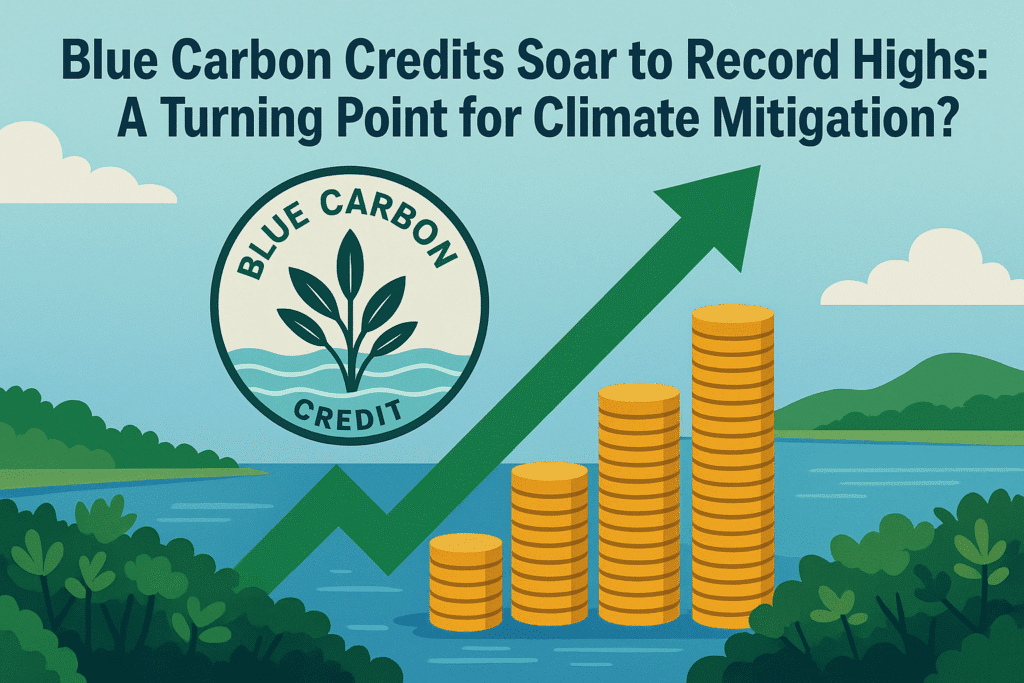In the ever-evolving landscape of carbon markets in September 2025, blue carbon credits have emerged as a premium asset, capturing the attention of investors, corporations, and policymakers alike. Derived from coastal and marine ecosystems such as mangroves, seagrasses, and salt marshes, these credits represent carbon sequestered in ocean-related environments. Recently, prices for blue carbon credits hit an all-time high in late August 2025, signaling a surge in demand that far outpaces supply and highlighting their growing role in global efforts to combat climate change and coastal erosion.
What Are Blue Carbon Credits?
Blue carbon refers to the carbon captured and stored by oceanic and coastal ecosystems. These habitats, though covering only about 2% of the ocean’s surface, account for roughly 50% of its carbon storage due to their dense vegetation and sediment-trapping abilities. Mangroves, for instance, can sequester up to five times more carbon than tropical forests. Beyond carbon sequestration, these ecosystems provide critical co-benefits, including biodiversity protection, flood prevention, reduced water acidification, and economic opportunities for local communities through fisheries and tourism.
Blue carbon credits are generated through projects that conserve or restore these ecosystems, allowing entities to offset their emissions by purchasing verified reductions or removals. Unlike traditional forest-based offsets, blue carbon projects often command higher prices due to their verifiable integrity and additional sustainable development impacts. In the voluntary carbon market (VCM), blue carbon remains a niche but high-value segment, with average prices ranging from $13 to $35 per tonne of CO₂ equivalent (tCO₂e), and some reaching as high as $40.
The Record-Breaking Price Surge
In late August 2025, blue carbon credit prices under the Platts DBC-1 benchmark reached a record $29.30 per metric ton of CO₂ equivalent (mtCO₂e) on August 28, marking the highest level since the benchmark’s launch in March 2024. This represented a $1.30/mtCO₂e increase from the previous day and a 14.9% rebound from a five-month low earlier in the month. Consistent bids above $29/mtCO₂e were reported throughout the week starting August 25, with a notable trade at $30.50/mtCO₂e on August 27.
By 2025, the average price for blue carbon credits had climbed to $29.72, a staggering 257% increase from previous years (e.g., $11.58 in 2022 and $8.33 in 2023). This premium far exceeds the broader VCM average, underscoring the market’s preference for these credits.
Drivers of the Demand Boom
The price spike is primarily driven by surging demand outstripping limited supply. Key factors include:
- Corporate Net-Zero Commitments: Companies are increasingly seeking high-integrity offsets to meet decarbonization goals. Blue carbon’s dual benefits—climate mitigation and ecological enhancements—make it a preferred choice, especially for sectors like shipping and tourism.
- Policy and Regulatory Support: Governments in regions like Southeast Asia, Africa, and Latin America are expanding programs to protect coastal ecosystems, boosting investor confidence. The Paris Agreement’s Article 6 could further integrate blue carbon into compliance markets, amplifying demand.
- Market Credibility and Co-Benefits: Projects aligned with Sustainable Development Goals (SDGs) or community development can fetch 15%–40% premiums, with SDG-linked credits commanding up to 86% more. This appeals to buyers wary of greenwashing in the VCM.
These ecosystems capture carbon up to four times faster than forests and store it for centuries, making them vital for long-term climate strategies.
Supply Challenges Persist
Despite the demand, supply remains constrained, with annual issuances below 10 million mtCO₂e—far short of global needs. Challenges include:
- Complex project development due to land tenure issues, regulatory uncertainties, and lengthy verification processes.
- High costs and capacity gaps in developing nations, where most potential lies.
- Ecosystem degradation, releasing up to 450 million metric tons of CO₂ annually from lost habitats.
These bottlenecks contribute to the price volatility and premium valuations.
Implications and Future Outlook
The record highs reflect investor interest in high-integrity marine offsets amid broader climate efforts. If scaled, blue carbon projects could offset up to 3% of global emissions by 2030, enhancing mitigation, adaptation, and biodiversity. Financial institutions are launching specialized funds, and standards bodies like Verra and Gold Standard are refining methodologies to build trust.
For investors, this presents opportunities for long-term appreciation, though supply growth is essential to stabilize prices. Companies may face higher costs, necessitating long-term offtake agreements, while policymakers should prioritize clear regulations and incentives.
As the VCM matures, blue carbon is poised to shift from niche to mainstream, playing a pivotal role in sustainable development and climate resilience.
References
- Platts Blue Carbon credit price at record high amid strong demand… – https://www.spglobal.com/commodity-insights/en/news-research/latest-news/energy-transition/082825-platts-blue-carbon-credit-price-at-record-high-amid-strong-demand-limited-supply-for-dbc-1 (Published: Aug 28, 2025)
- Blue Carbon Credits Reach Record High Amid Growing Global… – https://climatora.com/climate-watch/blue-carbon-credits-reach-record-high-amid-growing-global-demand/ (Published: ~Sep 2, 2025)
- The Blue Carbon Premium – https://invert.world/the-blue-carbon-premium/
- The Ultimate Guide to Blue Carbon – https://cloverly.com/blog/the-ultimate-guide-to-blue-carbon (Published: Feb 28, 2025)
- Blue Carbon Credits Hit Record High as Demand Outpaces Supply – https://carboncredits.com/blue-carbon-credits-hit-record-high-as-demand-outpaces-supply/ (Published: Sep 3, 2025)

